Bosch RS20 User Manual

IMPORTANT: |
IMPORTANT : |
IMPORTANTE: |
Read Before Using |
Lire avant usage |
Leer antes de usar |
|
|
|
Operating/Safety Instructions 
 Consignes de fonctionnement/sécurité
Consignes de fonctionnement/sécurité
Instrucciones de funcionamiento y seguridad
RS20
|
Call Toll Free |
Pour renseignement des |
Llame gratis para |
|
for Consumer Information |
consommateurs et centres |
obtener información |
||
|
& Service Locations |
de service, appelez au |
para el consumidor y |
|
|
|
numéro gratuit : |
ubicaciones de servicio |
|
|
|
|
||
|
1-877-BOSCH99 (1-877-267-2499) www.boschtools.com |
|
||
|
|
|
|
|
For English |
Parlez-vous français? |
¿Habla español? |
||
See page 2 |
Voir page 12 |
Ver página 22 |
||
|
|
|
|
|

|
Power Tool Safety Rules |
|
Read and understand all instructions. Failure to follow all instructions listed |
! WARNING |
|
|
below, may result in electric shock, fire and/or serious personal injury. |
|
|
|
SAVE THESE INSTRUCTIONS |
Work Area
Keep your work area clean and well lit.
Cluttered benches and dark areas invite accidents.
Do not operate power tools in explosive atmospheres, such as in the presence of flammable liquids, gases, or dust. Power tools create sparks which may ignite the dust or fumes.
Keep by-standers, children, and visitors away while operating a power tool.
Distractions can cause you to lose control.
Do not abuse the cord. Never use the cord to carry the tools or pull the plug from an outlet. Keep cord away from heat, oil, sharp edges or moving parts. Replace damaged cords immediately. Damaged cords increase the risk of electric shock.
When operating a power tool outside, use an outdoor extension cord marked "W-A" or "W." These cords are rated for outdoor use and reduce the risk of electric shock. Refer to “Recommended sizes of Extension Cords” in the Accessory section of this manual.
Electrical Safety
Grounded tools must be plugged into an outlet properly installed and grounded in accordance with all codes and ordinances. Never remove the grounding prong or modify the plug in any way. Do not use any adaptor plugs. Check with a qualified electrician if you are in doubt as to whether the outlet is properly grounded. If the tools should electrically malfunction or break down, grounding provides a low resistance path to carry electricity away from the user. Improper grounding can shock, burn or electrocute. Grounded tools are equipped with three conductor cord and three prong type plugs.
Before plugging in the tool be certain the outlet voltage supplied is within the voltage marked on the nameplate. Do not use “AC only” rated tools with a DC power supply.
Avoid body contact with grounded surfaces such as pipes, radiators, ranges and refrigerators. There is an increased risk of electric shock if your body is grounded. If operating the power tool in damp locations is unavoidable, a Ground Fault Circuit Interrupter must be used to supply the power to your tool. Electrician’s rubber gloves and footwear will further enhance your personal safety.
Don't expose power tools to rain or wet conditions. Water entering a power tool will increase the risk of electric shock.
Personal Safety
Stay alert, watch what you are doing and use common sense when operating a power tool. Do not use tool while tired or under the influence of drugs, alcohol, or medication. A moment of inattention while operating power tools may result in serious personal injury.
Dress properly. Do not wear loose clothing or jewelry. Contain long hair. Keep your hair, clothing, and gloves away from moving parts. Loose clothes, jewelry, or long hair can be caught in moving parts. Keep handles dry, clean and free from oil and grease.
Avoid accidental starting. Be sure switch is “OFF” before plugging in. Carrying tools with your finger on the switch or plugging in tools that have the switch “ON” invites accidents.
Remove adjusting keys or wrenches before turning the tool “ON”. A wrench or a key that is left attached to a rotating part of the tool may result in personal injury.
Do not overreach. Keep proper footing and balance at all times. Proper footing and balance enables better control of the tool in unexpected situations.
Use safety equipment. Always wear eye protection. Dust mask, non-skid safety shoes, hard hat, or hearing protection must be used for appropriate conditions.
-2-

Tool Use and Care
Use clamps or other practical way to secure and support the workpiece to a stable platform. Holding the work by hand or against your body is unstable and may lead to loss of control.
Do not force tool. Use the correct tool for your application. The correct tool will do the job better and safer at the rate for which it is designed.Do not use tool if switch does not turn it “ON” or “OFF”. Any tool that cannot be controlled with the switch is dangerous and must be repaired.
Disconnect the plug from the power source before making any adjustments, changing accessories, or storing the tool.
Such preventive safety measures reduce the risk of starting the tool accidentally.
Store idle tools out of reach of children and other untrained persons. Tools are dangerous in the hands of untrained users.
Maintain tools with care. Keep cutting tools sharp and clean. Properly maintained tools, with sharp cutting edges are less likely to bind and are easier to control. Any alteration or modification is a misuse and may result in a dangerous condition.
Check for misalignment or binding of moving parts, breakage of parts, and any
other condition that may affect the tools operation. If damaged, have the tool serviced before using. Many accidents are caused by poorly maintained tools. Develop a periodic maintenance schedule for your tool.
Use only accessories that are recommended by the manufacturer for your model. Accessories that may be suitable for one tool, may become hazardous when used on another tool.
Service
Tool service must be performed only by qualified repair personnel. Service or maintenance performed by unqualified personnel could result in a risk of injury. For example: internal wires may be misplaced or pinched, safety guard return springs may be improperly mounted.
When servicing a tool, use only identical replacement parts. Follow instructions in the Maintenance section of this manual.
Use of unauthorized parts or failure to follow Maintenance Instructions may create a risk of electric shock or injury. Certain cleaning agents such as gasoline, carbon tetrachloride, ammonia, etc. may damage plastic parts.
Safety Rules for Reciprocating Saws
Hold tool by insulated gripping surfaces when performing an operation where the cutting tool may contact hidden wiring or its own cord. Contact with a "live" wire will make exposed metal parts of the tool "live" and shock the operator. Do not drill, fasten or break into existing walls or other blind areas where electrical wiring may exist. If this situation is unavoidable, disconnect all fuses or circuit breakers feeding this worksite.
Never leave the trigger locked "ON". Before plugging the tool in, check that the trigger lock is "OFF". Accidental start-ups could cause injury.
Keep hands away from cutting area. Do not reach under the material being cut.
The proximity of the blade to your hand is hidden from your sight.
Keep hands from between the gear housing and saw blade holder. The reciprocating blade holder can pinch your fingers.
Do not use dull or damaged blades. Bent blade can break easily or cause kickback.
Before starting to cut, turn tool "ON" and allow the blade to come to full speed.
Tool can chatter or vibrate if blade speed is too slow at beginning of cut and possibly kickback.
Always wear safety goggles or eye protection when using this tool. Use a dust mask or respirator for applications which generate dust.
Secure material before cutting. Never hold it in your hand or across legs. Small or thin material may flex or vibrate with the blade, causing loss of control.
-3-

Make certain all adjusting screws and the blade holder are tight before making a cut. Loose adjusting screws and holders can cause the tool or blade to slip and loss of control may result.
When removing the blade from the tool avoid contact with skin and use proper protective gloves when grasping the blade or accessory. Accessories may be hot after prolonged use.
When using the saw hook always be aware that the the blade is exposed.
Always hang the tool in an area where yourself and bystandards can not accidently make contact with the blade.
Some dust created by ! WARNING power sanding, sawing,
grinding, drilling, and other construction activities contains chemicals known to cause cancer, birth defects or other reproductive harm. Some examples of these chemicals are:
•Lead from lead-based paints,
•Crystalline silica from bricks and cement and other masonry products, and
•Arsenic and chromium from chemicallytreated lumber.
Your risk from these exposures varies, depending on how often you do this type of work. To reduce your exposure to these chemicals: work in a well ventilated area, and work with approved safety equipment, such as those dust masks that are specially designed to filter out microscopic particles.
-4-
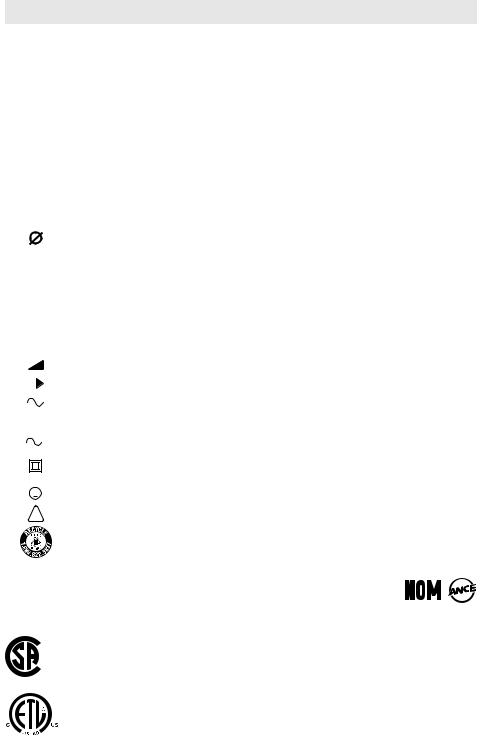
Symbols
IMPORTANT: Some of the following symbols may be used on your tool. Please study them and learn their meaning. Proper interpretation of these symbols will allow you to operate the tool better and safer.
Symbol |
Name |
|
Designation/Explanation |
|
|
|
|
|
|||||
|
|
V |
Volts |
|
Voltage (potential) |
|
|
|
|
|
|||
|
|
A |
Amperes |
|
Current |
|
|
|
|
|
|||
|
|
Hz |
Hertz |
|
Frequency (cycles per second) |
||||||||
|
|
W |
Watt |
|
Power |
|
|
|
|
|
|||
|
|
kg |
Kilograms |
|
Weight |
|
|
|
|
|
|||
|
min |
Minutes |
|
Time |
|
|
|
|
|
||||
|
|
s |
Seconds |
|
Time |
|
|
|
|
|
|||
|
|
|
|
|
|
Diameter |
|
Size of drill bits, grinding wheels, etc. |
|||||
|
|
n0 |
No load speed |
|
Rotational speed, at no load |
||||||||
.../min |
Revolutions or reciprocation per minute |
Revolutions, strokes, surface speed, |
|||||||||||
|
|
|
|
|
|
|
|
orbits etc. per minute |
|
|
|
|
|
0 |
|
|
|
Off position |
|
Zero speed, zero torque... |
|||||||
1, 2, 3, ... |
Selector settings |
|
Speed, torque or position settings. |
||||||||||
I, II, III, |
|
|
Higher number means greater speed |
||||||||||
0 |
|
|
|
|
Infinitely variable selector with off |
|
Speed is increasing from 0 setting |
||||||
|
|
|
|
|
|
Arrow |
|
Action in the direction of arrow |
|||||
|
|
|
|
|
|
|
|||||||
|
|
|
|
|
|
|
|||||||
|
|
|
|
|
|
Alternating current |
|
Type or a characteristic of current |
|||||
|
|
|
|
|
|
Direct current |
|
Type or a characteristic of current |
|||||
|
|
|
|
|
|
|
|||||||
|
|
|
|
|
|
Alternating or direct current |
|
Type or a characteristic of current |
|||||
|
|
|
|
|
|
|
|||||||
|
|
|
|
|
|
Class II construction |
|
Designates Double Insulated |
|||||
|
|
|
|
|
|
|
|||||||
|
|
|
|
|
|
|
|
Construction tools. |
|
|
|
|
|
|
|
|
|
|
|
|
|
|
|
|
|
|
|
|
|
|
|
|
|
Earthing terminal |
|
Grounding terminal |
|
|
|
|
|
|
|
|
|
|
|
|
|
|
|
|
|
||
|
|
|
|
|
|
Warning symbol |
|
Alerts user to warning messages |
|||||
|
|
|
|
|
|
|
|||||||
|
|
|
|
|
|
|
|||||||
|
|
|
|
|
|
Ni-Cad RBRC seal |
|
Designates Ni-Cad battery recycling |
|||||
|
|
|
|
|
|
|
|
program |
|
|
|
|
|
|
|
|
|
|
|
|
|
|
|
|
|
|
|
|
|
|
|
|
This symbol designates |
This symbol designates |
|
|
|
|
|
||
|
|
|
|
|
that this tool is listed to |
|
|
|
|
|
|||
|
|
|
|
|
that this tool is listed by |
|
|
|
|
|
|||
|
|
|
|
|
|
|
|
|
|
||||
|
|
|
|
|
Canadian Standards by |
|
|
|
|
|
|||
|
|
|
|
|
Underwriters Laboratories. |
|
|
|
|
|
|||
|
|
|
|
|
Underwriters Laboratories. |
This symbol |
|||||||
|
|
|
|
|
|
|
|||||||
|
|
|
|
|
|
|
This symbol designates that |
||||||
|
|
|
|
|
This symbol designates |
designates |
|||||||
|
|
|
|
|
this tool is listed by |
that |
|||||||
|
|
|
|
|
that this tool is listed by |
Underwriters Laboratories, |
this tool |
||||||
|
|
|
|
|
the Canadian Standards |
and listed to Canadian |
complies |
||||||
|
|
|
|
|
Association. |
Standards by Underwriters |
to NOM |
||||||
|
|
|
|
|
|
|
Laboratories. |
Mexican |
|||||
|
|
|
|
|
|
|
|
|
Standards. |
||||
This symbol designates that this tool is listed by
Intertek Testing Services.
-5-
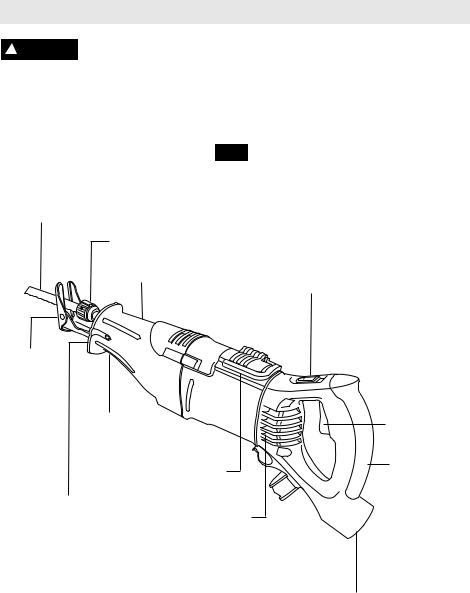
Functional Description and Specifications
! WARNING Disconnect the plug from the power source before making any assembly, adjustments or changing accessories. Such preventive safety
measures reduce the risk of starting the tool accidentally.
Reciprocating Saw
FIG. 1
SAW BLADE
LockJaw™ BLADE HOLDER |
|
|
||
|
|
RUBBER BOOT |
|
DUAL SPEED |
|
|
|||
|
|
|
|
SELECTOR SWITCH |
|
|
|
|
|
PIVOTING
FOOTPLATE
|
|
VARIABLE |
FOOTPLATE |
|
SPEED |
|
CONTROLLED |
|
RELEASE |
|
|
|
TRIGGER |
|
BUTTON |
|
|
|
|
|
|
SAW HOOK |
RUBBERIZED |
|
SOFT GRIP |
|
|
|
JOB-LIGHT
AIR VENT
DIRECT CORD
CONNECT SYSTEM
NOTE: For tool specifications refer to the nameplate on your tool.
-6-
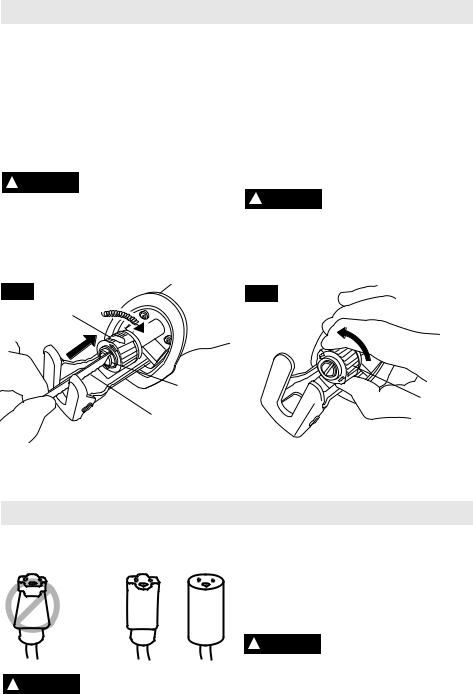
Assembly
Preparing the Saw
BLADE SELECTION
No one blade can be efficient on all cutting jobs. Different materials require specially designed blades. Since your reciprocating saw can cut so many materials, many types of BOSCH blades are available. Be sure to use the proper blade to insure proper cutting performance.
INSTALLING A BLADE
! WARNING Unplug tool from power source before changing blade
or making any adjustments.
1. Insert the blade into the LockJaw™ blade holder until the locking collar automatically rotates clockwise and locks the blade in place (Fig. 2). Note: if the blade will not lock automatically, rotate the locking collar counter-
FIG. 2
clockwise until it clicks and locks in the open position (Fig. 3).
2 Push in and pull out on the blade to be sure the pin in the clamp housing goes through the hole in the blade to hold the blade securely. The blade may be inserted with the teeth facing down or up.
3. To remove the blade, rotate the locking collar counter-clockwise and the blade will automatically eject from the LockJaw™ blade holder and lock the collar in the open position.
! WARNING Make sure that the front end of the blade extends through
the footplate for the entire stroke length. Do not use specialty blades that are very short or those with a significant cant. Blade must not contact footplate. A blade which is too short or canted could jam inside the foot and snap.
FIG. 3
LOCKING |
Open |
COLLAR |
|
|
Position |
LockJaw™ |
|
BLADE HOLDER |
LOCKING |
BLADE |
COLLAR |
|
Operating Instructions
INSTALLING POWER CORD
Recommended:
To reduce the risk of ! WARNING injury and tool damage,
do not use extension cords that have receptacles bodies with sides that taper
towards the end of the receptacle. Use of this extension cord type may result in an intermittent electrical connection and cause arcing.
Only use extension cords that are UL Listed. For best performance, use BOSCH extension cords.
! WARNING DIRECT CORD CONNECT SYSTEM HAS BEEN
CONFIGURED TO BE USED WITH 12AWG SJ CORD, MAXIMUM LENGTH OF 50 FEET. INSPECT THE CORD, DO NOT USE IF DAMAGED.
-7-
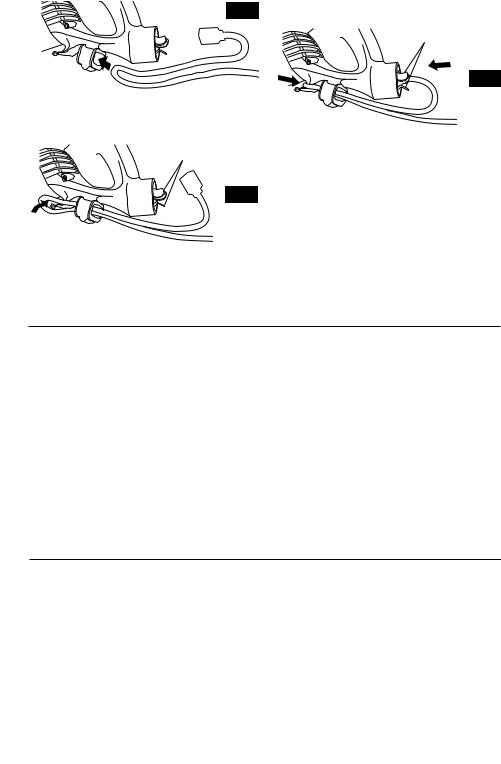
1. Loop cord as shown in figure 4.
FIG. 4
2. Insert looped end of cord through slot in handle and loop cord into channel provided in handle as shown figure. 5).
SPRING CLIP
FIG. 5
ATTENTION: before inserting plug into handle, always make sure you leave enough cord at plug end to avoid tension on plug when inserted into tool.
3. Push end of plug through spring clip and into female outlet in handle as shown in figure 6.
SPRING CLIP
FIG. 6
ATTENTION: Insure your cord is completely inserted into the handle and that it is fully seated against the Direct Connect end plug.
4 To remove plug from tool, simply remove from outlet and pull away from spring clip.
NOTE: If the spring clip does not securely hold the plug it may be necessary to lightly squeeze the clip together with a pliers.
If you have any questions or experience a problem with your Direct Connect system, contact us at 1-877-BOSCH99 or visit www.boschtools.com.
VARIABLE SPEED CONTROLLED
TRIGGER SWITCH
Your tool is equipped with a variable speed controlled trigger switch. The tool can be turned "ON" or "OFF" by squeezing or releasing the trigger. The blade plunger stroke rate can be adjusted from the minimum to maximum nameplate stroke rate by the pressure you apply to the trigger. Apply more pressure to increase the speed and release pressure to decrease speed (Fig. 1).
DUAL SPEED SELECTOR SWITCH
Your tool is equipped with two separate gear ranges, low gear and high gear. Low gear
provides slower cutting speeds for cutting hard materials such as metals or thin sheet metals. High gear provides faster speeds for cutting soft materials such as wood, plastics, etc. and when fast cutting is more important than a clean cut.
To change speeds slide switch, to the high or low position (Fig. 1).
JOB-LIGHT
Your tool is also equipped with a Job-light for better visibility during operation (Fig. 1).
When the tool is plugged in, the light will turn on automatically and stay on until the plug has been removed from the power source.
FOOTPLATE ADJUSTMENT
The footplate tilts in order to keep as much of its surface in contact with the work surface Fig. 7 (a).
The footplate assembly can also be locked into one of three projection positions to optimize blade life and/or to reduce blade protrusion beyond the end of the footplate, such as when cutting into large diameter pipe
or into walls. To adjust the footplate position, simply push the footplate release button and move the footplate into the desired position. The locking mechanism is spring-loaded to lock into one of the 3 positions on the footplate assembly. If the footplate is pulled out so far that a notch shows at the other end of the shaft, the footplate assembly is extended too far out, and must be retracted to the one of the 3 positions Fig. 7 (b).
-8-
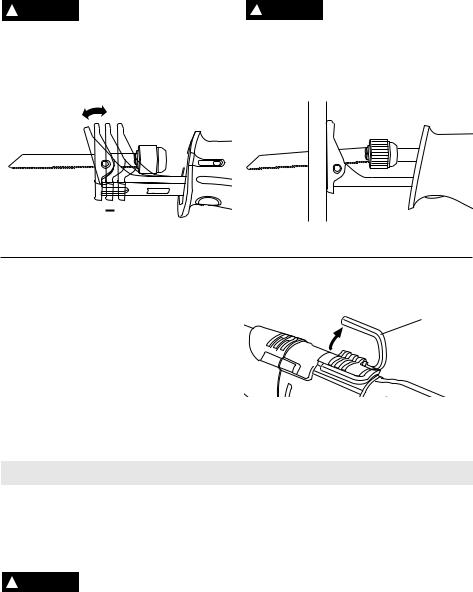
! WARNING Do not push the footplate release button while sawing.
It will cause the footplate to release from the desired settings and you may lose control and be injured.
(a)
! WARNING To reduce the risk of injury, be sure the blade extends
beyond the footplate and all the way through the workpiece throughout the stroke. Blades may shatter if the blade hits the footplate or hits the work at an angle that is nearly headon (Fig. 8).
FIG. 7 |
|
|
|
|
FIG. 8 |
||
|
|
|
|
|
|
|
|
|
|
|
|
|
|
|
|
|
|
|
|
|
|
|
|
|
|
|
|
|
|
|
|
|
|
|
|
|
|
|
|
|
|
|
|
|
|
|
|
|
|
|
|
|
|
|
|
|
|
|
|
|
|
|
|
|
|
|
|
|
|
|
|
|
|
|
|
|
|
|
|


 (b)
(b)
SAW HOOK |
|
|
FIG. 9 |
||
Your tool is equipped with a convenient saw |
||
|
||
hook for hanging your tool. To use, simply |
|
|
lift up hook until it snaps into the open |
|
|
position (Fig. 9). |
|
|
When not in use, always lower hook until it |
|
|
snaps into the closed position. |
|
SAW HOOK
Using the Saw
1. Securely clamp the work.
2. Mark the line of cut and grasp the tool with one hand on the handle and the other placed on the insulated rubber boot over the front housing.
! WARNING Always hold the saw by the insulated boot on the front
housing. If you saw into a blind area where live wiring exists, you may be shocked or electrocuted.
3.Keep the saw footplate firmly against the work to minimize counter-force (jumping) and vibration.
4.Squeeze the trigger to start the tool. Let the saw reach full speed before starting the cut.
Guide the saw so that the blade will move along the marked line.
SAWING TIPS
Following a few simple tips will reduce the wear on the workpiece, the tool and the operator.
1.Blades cut on the draw or back stroke. On fine work, such as paneling, fiberglass, etc., place the good side of workpiece facing down.
2.Use the correct saw blade for the material being cut and keep extra blades on hand to use when others become dull. Replace cracked or bent blades immediately.
3.Select the appropriate cutting speed.
-9-
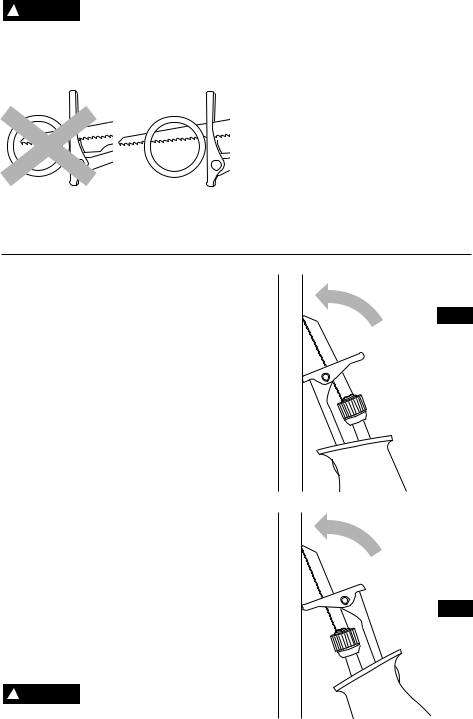
! WARNING To reduce the risk of injury, be sure the blade always
extends beyond the footplate and work throughout the stroke. Blades may shatter if the front on the blade hits the work and/or the footplate.
WRONG |
RIGHT |
4.When cutting metal:
-Apply a lubricant for easier, smoother, faster cutting and longer blade life.
-For non-ferrous metals, aluminum, bronze or brass, use a stick wax on the blade.
-For ferrous metals, iron and steel, use machine or cutting oil along the surface to be cut.
5.When cutting thin metal, "sandwich" the material between two pieces of scrap wood. Clamp or put in a bench vise. One piece of lumber on top of the metal can be used with adequate clamping. Place your cut lines or design on the wood.
6.Don’t force the cutting. Let the saw and blade do the work.
POCKET CUTS
POCKET/PLUNGE CUTS
The reciprocating saw can be used to make plunge cuts into softer material, (for example, wood or light building materials for walls), without a starting hole (Fig. 10).
1.Mark the line to be cut clearly on the work.
2.Set the tool with one edge of the footplate firmly against the material.
3.Place the tip of the blade (not running) on the line to be cut.
4.Tilt the saw so that the blade clears the work.
5.Squeeze the trigger switch and carefully engage the moving saw blade into the material.
6.After the blade penetrates through the work, continue sawing along the marked outline.
NOTES:
To make plunge cutting easier, use a heavy gauge blade, install the blade with the teeth facing upward, and hold the saw upside down as shown (Fig. 11).
Do not plunge cut in metal surfaces.
In thick materials and in harder materials, such as metal, plunge cutting should not be attempted. Such materials can be cut with the recip saw only by starting the cut from the edge of the material or from a hole drilled all the way through the material that is large enough to fit the saw blade.
! WARNING The use of any accessories not specified in this manual
may create a hazard.
FIG. 10
FIG. 11
-10-
